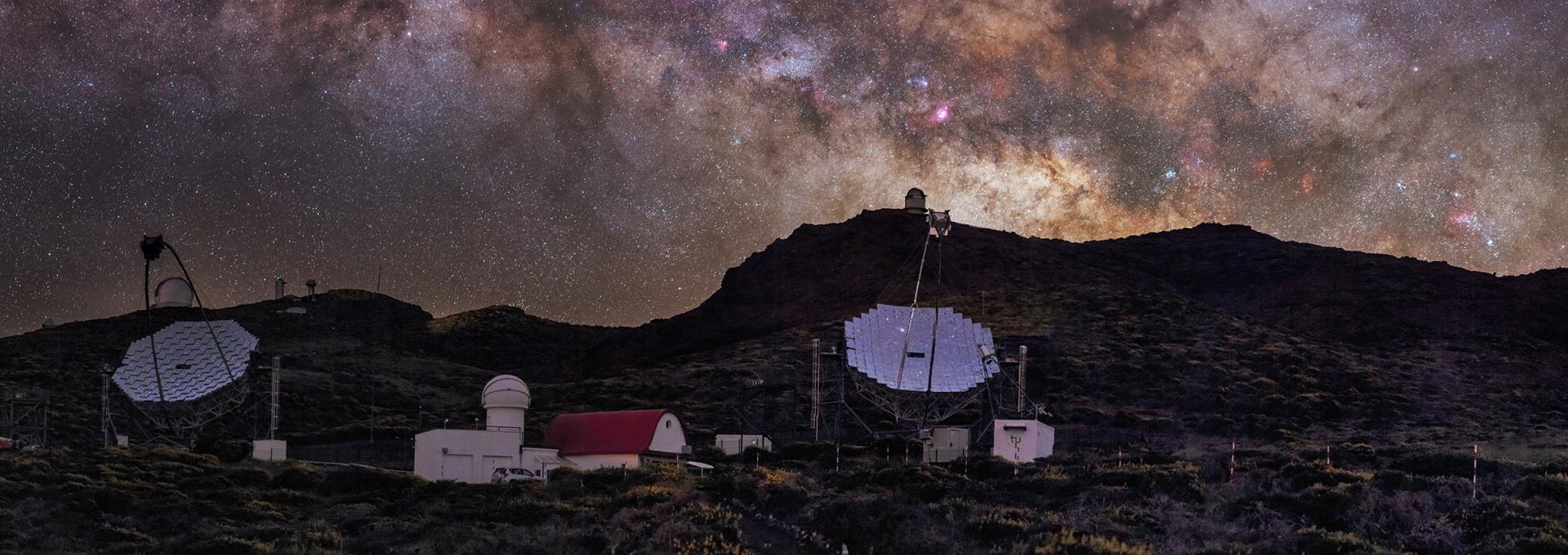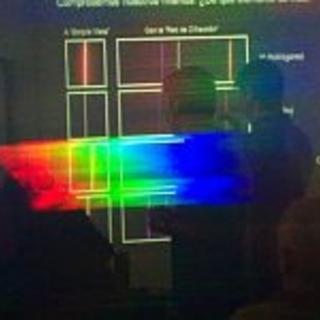MAGIC Telescopes


The cosmos and its evolution are studied using all radiation, in particular electromagnetic waves. The observable spectrum extends from radio waves to infrared, visible, ultraviolet, X-ray, gamma-rays and finally very high energy gamma rays (starting at energies of 10 GeV). Observations at visible wavelengths (.5 to 1 micrometer) have a history of centuries, gamma astronomy by satellites (keV to few GeV) and ground-based telescopes (above 300 GeV) are end-of-20th century newcomers. The MAGIC telescope can detect very high energy gamma rays in a range of energies where no other telescope in the world can operate, so it opens up a brand new window into the universe.
"Cherenkov Telescopes" are telescopes for the detection of very high energy gamma rays.
Although they get absorbed in the atmosphere, they can be observed indirectly, because the absorption process proceeds by creation of a shower of high-energy secondary particles. The Cherenkov method uses the fact that the charged particles in the shower emit light, the so-called Cherenkov radiation. This light can be observed on the surface of the earth by sufficiently sensitive an instrument: a Cherenkov telescope.
MAGIC is not only huge but also pioneers a number of technical developments that had never been applied to Cherenkov telescopes before. The mirror is extremely light and can be moved to any position in the sky in less than thirty seconds.
It is made up of 270 individual mirror panels that can be independently focussed using an active mirror control system equipped with lasers.
The camera, fully built in Spain, is equipped with several hundreds of very sensitive and extremely fast photodetectors. The signals produced in these detectors are trasmitted over optical fibers to special electronics that digitize them at the fastest rate ever used for this kind of detectors.
Many attempts to detect high-energy gamma rays with air shower arrays failed to provide convincing results. The breakthrough finally came with the Cherenkov telescopes, which were pioneered with the Whipple telescope in Arizona. In 1989 the Whipple group succeeded in establishing the Crab nebula as a strong galactic source of TeV gamma rays, and then discovered two extragalactic sources - the active galactic nuclei Markarian 421 and 501.
Another milestone was the construction beginning of the 90s of the HEGRA telescopes at La Palma which advanced the field even further by using more telescopes and stereo reconstruction. The success of Whipple and HEGRA led in 1996 to the idea of building a giant telescope, MAGIC, to cover the unexplored window in the electromagnetic spectrum that cannot be observed using satellites.
Most generally, the observation of gamma rays is one aspect of astroparticle physics. Astroparticle physics is a new field developing as an intersection of Particle Physics, Nuclear Physics, Astrophysics, Gravitation and Cosmology. One of its cornerstones is Cosmic Ray Physics, which has its origins many decades in the past; then scientists observed in balloons and in mountain top laboratories the many charged particles impinging upon the earth. Today, the field has substantially widened, and includes all particle.
Cosmic rays in particular are probably accelerated in the wake of supernova explosions where gas clouds expand into a bright shell. These shells should also copiously produce gamma rays.
There are quite a number of sources of gamma rays that are simply not identified . Many of them populate the galactic equator, hence can be expected to be in our own galaxy. MAGIC will collect more gamma rays from these sources, and thus pinpoint their positions and contribute to their identification.
Every day a few powerful stellar explosions illuminate the sky from all directions. These explosions are usually not visible with optical telescopes, but they are very bright in gamma rays. These gamma ray bursts last for seconds to minutes only. The energy observed makes them the beacons of most likely the most energetic events known in the universe. Discovered 30 years ago, these Gamma Ray Bursts have been objects for research and speculation ever since.
Observations of very high energy gammas will also allow searches for dark matter. This unkown component of our universe couldconsist on particles that annihilate into gamma rays that can be detected by MAGIC in the vicinity of the black holes of galactic centers (including our own).
MAGIC produced its first data in 2004. At the beginning of 2005 the telescope has tested its performance using the standard candle source in very high energy gamma rays, the Crab Nebula. MAGIC has detected this object in the new electromagnetic window to understand the mechanism that produces particles at high energies. Crab is a pulsar, that is, a very dense star that rotates tens of times per second and develops incredibly strong magnetic and eletric fields. MAGIC has also detected several active galactic nuclei. These are black holes millions of times heavier than our Sun that hide at the center of galaxies and generate gigantic flows of matter where particles are also accelerated and generate gamma rays.
